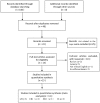Performance of real-time elastography for the staging of hepatic fibrosis: a meta-analysis
- PMID: 25541695
- PMCID: PMC4277316
- DOI: 10.1371/journal.pone.0115702
Performance of real-time elastography for the staging of hepatic fibrosis: a meta-analysis
Abstract
Background: With the rapid development of real-time elastography (RTE), a variety of measuring methods have been developed for the assessment of hepatic fibrosis. We evaluated the overall performance of four methods based on RTE by performing meta-analysis of published literature.
Methods: Online journal databases and a manual search from April 2000 to April 2014 were used. Studies from different databases that meet inclusion criteria were enrolled. The statistical analysis was performed using a random-effects model and fixed-effects model for the overall effectiveness of RTE. The area under the receiver operating characteristic curve (AUROC) was calculated for various means. Fagan plot analysis was used to estimate the clinical utility of RTE, and the heterogeneity of the studies was explored with meta-regression analysis.
Results: Thirteen studies from published articles were enrolled and analyzed. The combined AUROC of the liver fibrosis index (LFI) for the evaluation of significant fibrosis (F≥2), advanced fibrosis (F≥3), and cirrhosis (F = 4) were 0.79, 0.94, and 0.85, respectively. The AUROC of the elasticity index (EI) ranged from 0.75 to 0.92 for F≥2 and 0.66 to 0.85 for F = 4. The overall AUROC of the elastic ratio of the liver for the intrahepatic venous vessels were 0.94, 0.93, and 0.96, respectively. The AUROC of the elastic ratio of the liver for the intercostal muscle in diagnosing advanced fibrosis and cirrhosis were 0.96 and 0.92, respectively. There was significant heterogeneity in the diagnostic odds ratio (DOR) for F≥2 of LFI mainly due to etiology (p<0.01).
Conclusion: The elastic ratio of the liver for the intrahepatic vein has excellent precision in differentiating each stage of hepatic fibrosis and is recommend to be applied to the clinic.
Conflict of interest statement
Figures




References
-
- Kim S, Han K, Ahn S (2010) Non-invasive assessment of liver fibrosis: time to move from cross-sectional studies to longitudinal ones. J Gastroen Hepatol 25:1472. - PubMed
-
- Mohd Hanafiah K, Groeger J, Flaxman AD, Wiersma ST (2013) Global epidemiology of hepatitis C virus infection: new estimates of age-specific antibody to HCV seroprevalence. Hepatology 57:1333–1342. - PubMed
-
- Lok AS, McMahon BJ (2007) Chronic hepatitis B. Hepatology 45:507–539. - PubMed
-
- Germani G, Hytiroglou P, Fotiadu A, Burroughs AK, Dhillon AP (2011) Assessment of fibrosis and cirrhosis in liver biopsies: an update. Semin Liver Dis 31:82–90. - PubMed
Publication types
MeSH terms
LinkOut - more resources
Full Text Sources
Other Literature Sources
Medical
Miscellaneous

